A one-of-a-kind Textile Exhibition: “Nomad – The Art of Tribal Weaves Across Borders from Anatolia to Tibet” is ongoing at the National Crafts Museum, till 12th Februay 2024. This Nomad Exhibition is a journey into the largely unknown world of textiles from 19th and early 20th-century kilims and their unexpected ties to contemporary art at Delhi’s National Craft Museum.
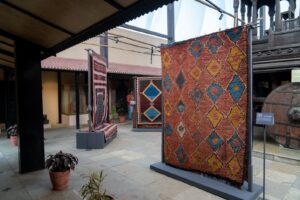 The Nomad exhibition, sponsored by Shades of India and curated by Amita Goel, is a successor to the exhibition of Central Asian suzani, ikats and rugs that showed in the National Crafts Museum last year.
The Nomad exhibition, sponsored by Shades of India and curated by Amita Goel, is a successor to the exhibition of Central Asian suzani, ikats and rugs that showed in the National Crafts Museum last year.
This 2-week long exhibition brings together some of the unique works from private collections of rugs, kilims (flat woven rugs), horse blankets and saddle bags from the region. Virtually all the 50-60 pieces on show are from the 19th or early 20th century. They were made from hand spun and hand-woven wool, mostly dyed in natural colours. But they have an amazingly contemporary sense of design.
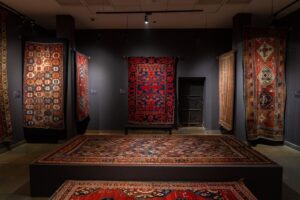 These textiles come from a vast region that stretches across eastern Turkey, through the Caucasus into Iran, and across to Turkestan. This is an area in which the textile culture is based on wool gathered from the nomadic tribes who drove their flocks of sheep, camel and goats from lowlands in the winter to the high mountain pastures in the summer.
These textiles come from a vast region that stretches across eastern Turkey, through the Caucasus into Iran, and across to Turkestan. This is an area in which the textile culture is based on wool gathered from the nomadic tribes who drove their flocks of sheep, camel and goats from lowlands in the winter to the high mountain pastures in the summer.
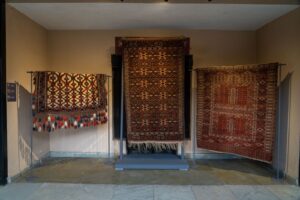 Often, people living in such primitive conditions, have had an extraordinary sense of colour, and form. Reds, indigo blue, green, yellow, black have the richness and durability that comes from the lengthy preparation of natural dyes. They created abstract designs that recall contemporary paintings. They drew into their art the birds, animals, flowers, figures and motifs that filled their daily lives.
Often, people living in such primitive conditions, have had an extraordinary sense of colour, and form. Reds, indigo blue, green, yellow, black have the richness and durability that comes from the lengthy preparation of natural dyes. They created abstract designs that recall contemporary paintings. They drew into their art the birds, animals, flowers, figures and motifs that filled their daily lives.
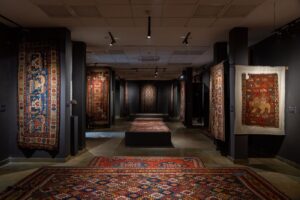 In such a vast area, different tribal groups – Kurds and Turks in Anatolia, Kurds from western Iran, the Shahsavan from the North West , the Qashgai, Bakhtiars, Khamseh and Afshar from the west and South of Iran, the Baluch and Turkmans from Eastern Iran and Turkestan to the north – each had a an artistic language of their own.
In such a vast area, different tribal groups – Kurds and Turks in Anatolia, Kurds from western Iran, the Shahsavan from the North West , the Qashgai, Bakhtiars, Khamseh and Afshar from the west and South of Iran, the Baluch and Turkmans from Eastern Iran and Turkestan to the north – each had a an artistic language of their own.
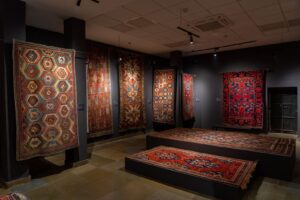 The movement of people – often due to their forced displacement – many motifs are common to different regions though interpreted differently. One of the most widely used is the boteh (paisley) which can be found in pieces from the Caucasus as well as from western Iran and Central Asia. The inspiration may well have come from India.
The movement of people – often due to their forced displacement – many motifs are common to different regions though interpreted differently. One of the most widely used is the boteh (paisley) which can be found in pieces from the Caucasus as well as from western Iran and Central Asia. The inspiration may well have come from India.
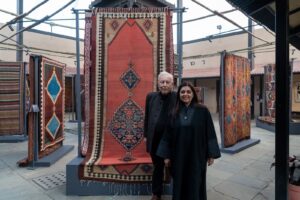
David and Mandeep Housego of Shades of India
The aim of this exhibition is to unfold to an Indian audience a tradition with which they may be less familiar. It draws on David and Mandeep Housego’s collections brought together over a long period of time with many pieces gathered on travels in the region itself. Danny and Renuka Mehra have also lent some outstanding pieces from their vast collection.
What: Explore across borders a unique tradition of 19th and early 20th century textiles through ‘Nomad’ – a personal collection on display at Delhi’s National Craft Museum.
Where: National Crafts Museum, Pragati Maidan, New Delhi
When: On till 12th February 2024
Timings: 10 am to 6pm
